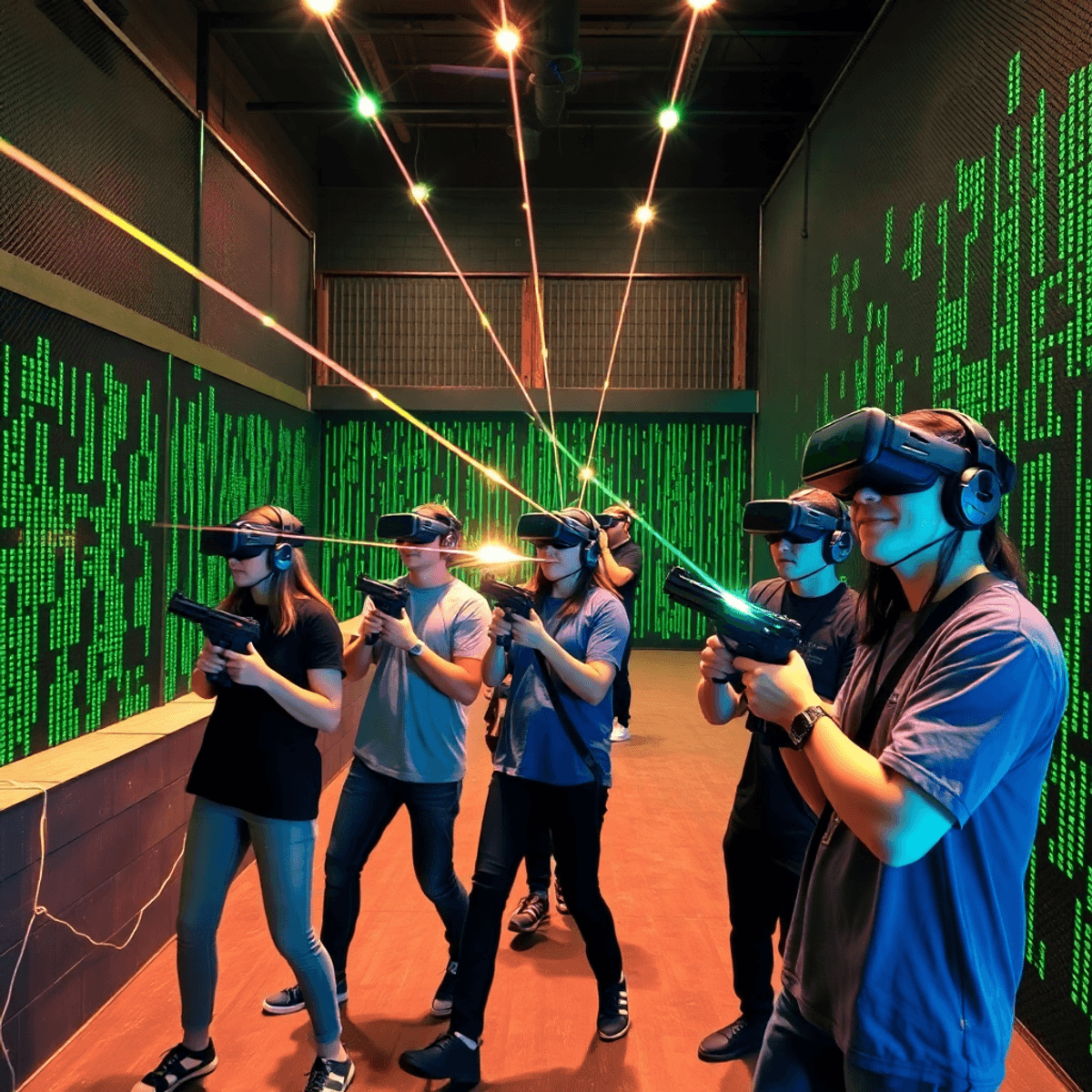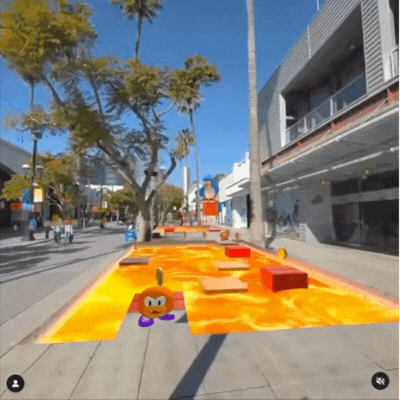
This innovative technology enables real-time, dynamic mapping of physical environments into virtual spaces, unlocking new possibilities for immersive VR and mixed reality (MR) experiences. Unlike traditional static scanning, continuous scene meshing updates spatial data on the fly, allowing virtual content to interact seamlessly with the real world.
Laser tag arenas represent a massive opportunity for VR transformation. With thousands of venues worldwide, these spaces can be reinvented as fully immersive VR attractions, delivering enhanced gameplay and rich mixed reality interactions. Creative Works attempted this go-to-market strategy a few years ago with Limitless VR. They used Matterport scans to convert arenas into virtual maps. The cost of doing this was too high, so they pivoted to smaller arenas with a few portable barriers. This requires FECs to clear precious floor space, from 600-1800 square feet.
Recent posts from developer Julian Triviri and picked up by Upload VR showcase how he’s using Quest’s newly released depth sensor API to build a continous, real-time, map of any space. Equipped with advanced environment scanning capabilities and powerful computational vision algorithms, these headsets generate detailed 3D meshes of rooms in real time. This spatial awareness empowers MR applications like laser tag to detect obstacles accurately, creating engaging experiences that blur the line between physical and virtual worlds.
But the reliance on machine vision in the Quest puts too much strain on the XR2 processor, meaning there’s not enough ooomph left to make real time, high resolution, multiplayer gaming assets. For mixed reality laser tag to work, headsets need to render avatars for as many players as can be seen at once, plus gun and environmental effects.
Continuous scene meshing technology creates a live, evolving 3D scene mesh of the environment, updating spatial data in real-time as users move through it. This is different from static scene scanning, where only one snapshot of the environment is taken and used without any updates. Static scans often become outdated when objects or lighting conditions change, which limits realism and interaction in mixed reality (MR) applications. Quest also struggles to remember maps, whereby platforms like HTC and Pico allow map storage and sharing as part of their LBE platforms.
For Quest, the Depth API is essential because it provides continuous, real-time depth frames from the headset’s sensors. These depth frames make it possible to have accurate dynamic occlusion, which means virtual objects can appear realistically behind or in front of real-world objects. Dynamic occlusion enhances immersion by seamlessly integrating digital content into physical spaces.
Continuous scene meshing ensures MR experiences remain fluid and responsive, delivering more authentic integration between virtual and real worlds through persistent spatial awareness powered by the Depth API.
The Quest 3 and Quest 3S devices use advanced technology to scan rooms and create spatial meshes for mixed reality (MR) applications like Laser Tag. These devices use the “Depth API on Quest Devices” to enable laser collision detection with real geometry, making the experience more immersive for users.
Continuous Scene Meshing holds the key to converting 5000 laser tag arenas to VR attractions. In this section, we will explore the use of Unity’s marching cubes algorithm to convert depth frames into usable mesh data for MR applications.
Continuous scene meshing revolutionizes the way you interact with mixed reality applications by eliminating the need for manual room setup. Traditionally, MR apps required users to perform an initial scan of their environment—often a time-consuming process that could take hours in a large laser tag arena. Without rock solid spatial mapping, the system just would not work. And if operators ever needed to rescan during the day, it would break down the operations.
With continuous scene meshing, apps bypass this hurdle entirely. The system dynamically updates the spatial mesh in real time, allowing you to launch the app and immediately engage with your physical environment without any pre-scan delays. This creates a seamless and intuitive experience where virtual elements naturally coexist with real-world geometry.
The upcoming Hauntify on Quest will fully leverage this continuous meshing technology. By integrating it into the app’s core functionality, Hauntify will:
This update highlights how continuous scene meshing not only improves user convenience but also reduces friction, encouraging more frequent use of mixed reality attractions in varied environments.
Continuous scene meshing technology opens up exciting possibilities for multi-level mixed reality experiences. Users can seamlessly navigate between different levels within a virtual environment, enhancing immersion and gameplay dynamics. Imagine exploring ramps and interconnected floors, all seamlessly integrated through continuous scene meshing.
Beyond indoor settings, continuous scene meshing can also revolutionize outdoor mixed reality applications like Dream Park from Two Bit Circus. By leveraging GPS data and advanced depth-sensing capabilities, users can engage in immersive experiences in outdoor environments. Picture a scenario where users participate in a treasure hunt or interactive storytelling experience in a park, with virtual elements seamlessly blending into the real-world surroundings.

By enabling multi-floor navigation and outdoor mixed reality use cases, continuous scene meshing technology enables mixed reality attractions to utilize underutilized existing space . The seamless integration of virtual content into diverse physical environments creates endless possibilities for interactive entertainment experiences.
Continuous scene meshing requires finding the right balance between performance cost and the level of detail needed for an immersive XR experience. This balance is crucial when turning 5000 laser tag arenas into XR attractions, where real-time environment mapping must not compromise device responsiveness.
Balancing these factors lets you harness continuous scene meshing effectively, ensuring VR laser tag arenas deliver dynamic and reliable mixed reality interactions without overwhelming hardware limitations.
Developers aiming to integrate continuous scene meshing into VR and MR applications have access to robust SDK features designed to expose spatial mesh data. These tools allow you to:
The availability of developer source code and sample projects from platforms like Meta Quest provides practical examples and accelerates implementation. Unity plugins leveraging algorithms such as marching cubes are often included or supported, enabling smooth conversion of raw depth data into usable meshes.
Also, Julian Triveri has posted his continous meshing code on GitHub.
These resources empower developers to optimize mesh fidelity, adjust update frequencies, and balance performance depending on the target hardware capabilities. You gain control over how your application interprets and responds to the physical space, unlocking immersive experiences beyond static scene reconstructions.
Meta’s current scene mesh system has several key limitations that affect seamless mixed reality experiences.
One of the main challenges is that scene meshes need to be updated manually. Even though Meta plans to automate updates in the future, the current system still requires an initial scan and regular rescanning to accurately capture changes in the environment. This manual process creates friction and disrupts the smoothness expected in MR applications.
Triveri’s code ignores Meta’s scene meshing. But future updates to Meta Quest software and firmware could easily break any integration of third party code.
Another limitation comes from the fact that scanned meshes are static. Scene meshes only represent a specific moment in time and do not adapt over time. Moving objects or rearranged furniture in dynamic environments can quickly make these meshes outdated unless they are actively refreshed.
The nice thing about continuous scene meshing is that it dynamically updates. Laser tag arenas with movable obstacles don’t require new scans.
Performance is also a crucial factor to consider. Quest 3 and Quest 3S rely on complex computer vision algorithms to create spatial meshes, unlike devices such as Apple Vision Pro or Pico 4 Ultra that use hardware-level depth sensors. This difference leads to increased GPU/CPU workload, which affects battery life and limits extended use of continuous meshing features.
Networking multiple devices for shared scene understanding is another challenge but adds complexity when it comes to synchronization and data consistency. While experimental methods like networked heightmapping show potential, they are not yet ready for production use.
To overcome these limitations, we need innovations in:
Continued development will bring continuous scene meshing closer to truly immersive and adaptable mixed reality experiences. This is crucial for large-scale VR attractions like laser tag arenas and beyond.
Continuous Scene Meshing holds the key to converting 5000 laser tag arenas to VR attractions. It’s the biggest addressable market for location-based virtual reality.
The future of interactive entertainment experiences lies in the hands of developers and venue operators. By exploring the implementation of continuous scene meshing using modern SDKs and hardware advancements, we can create next-generation attractions that seamlessly blend the physical and virtual worlds.
It’s time to embrace this technology and unlock new possibilities for immersive entertainment. The potential is vast, and those who dare to innovate will reap the rewards in this ever-evolving industry.

